Motorola Moto G6 Xt1925 32gb Dual Sim (Factory Unlocked) Android Gsm 12mp 57 Review
Motorola Moto G6 Smartphone Review
G as in genius? The latest offshoot of the Motorola-G series is advertised self-confidently and presents itself as a successful advancement of the Moto G5s. A faster SoC, a dual camera, and an updated design are supposed to attract customers. You tin can find out nigh the qualities and weaknesses of the Moto smartphone in this examination.
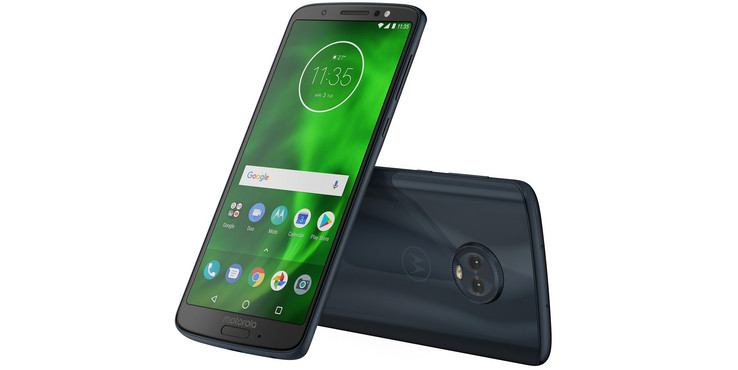
With this yr'southward Moto Yard, Motorola introduces the sixth generation of the midrange smartphone, also changing from the 16:9 to the ii:1 format of the brandish. A dual photographic camera and a newer processor are also added now. Compared to the Moto G5s the storage equipment has remained unchanged in our test unit, offering three GB of working memory and 32 GB of internal storage, which can be expanded via a microSD card. Amazon also has an sectional offer for a model with 4 GB of RAM and 64 GB of storage. The following tabular array shows the differences betwixt the Motorola Moto G6 (XT1925-5), its predecessor, and the 2 other models of the serial, the Moto G6 Plus and Moto G6 Play.
| . | Moto G6 | Moto G5s | Moto G6 Play | Moto G6 Plus |
|---|---|---|---|---|
| Display | v.seven in, 2:1, IPS, 2160x1080 pixels, Gorilla Glass 3 | five.2 in, 16:ix, IPS, 1920x1080 pixels, Gorilla Drinking glass three | 5.vii in, ii:1, IPS, 1440x720 pixels, standard drinking glass | 5.ix in, 2:i, IPS, 2160x1080 pixels, Gorilla Glass 3 |
| SoC | Snapdragon 450 | Snapdragon 430 | Snapdragon 430 | Snapdragon 630 |
| RAM | 3 GB | 3 GB | 3 GB | four GB |
| Storage | 32 GB | 32 GB | 32 GB | 64 GB |
| Bone | Android viii.0 | Android vii.1 | Android 8.0 | Android 8.0 |
| Battery | 3000 mAh | 3000 mAh | 4000 mAh | 3200 mAh |
| Main camera | 12 + five MP (f/i.viii) | 16 MP (f/2.0) | xiii MP (f/2.0) | 12 + 5 MP (f/1.7, DPAF) |
| Front camera | eight MP | five MP | eight MP | 8 MP |
| USB | USB two.0, Blazon C | USB 2.0, Micro-USB | USB two.0, Micro-USB | USB 2.0, Blazon C |
| Price | 249 Euros (~$298; ~$250 in the US) | 249 Euros (~$298) | 199 Euros (~$238) | 299 Euros (~$357) |
The Moto G half-dozen is advertised with the tagline "Premium for Everyone." Those are big words for a relatively affordable smartphone, which we are comparison confronting competitors of the same price range in our test. Foremost, at that place is the ZTE Blade V9, which offers very like equipment with the same SoC, followed by the Samsung Galaxy J7 (2017), the Honor 9 Calorie-free, and the Nokia 6 (2018). Smartphones such every bit the BQ Aquaris X Pro that were expensive at some point are simply marginally more expensive at the time of this exam.
Brandish
5.70 inch two:1, 2160 x 1080 pixel 424 PPI, capacitive touchscreen, 10 multitouch points, IPS, Corning Gorilla Glas 3, sleeky: yes
Weight
167 k ( = v.89 oz / 0.37 pounds) ( = 0 oz / 0 pounds)
Note: The manufacturer may employ components from different suppliers including display panels, drives or memory sticks with similar specifications.
Instance - Motorola has turned away from aluminum
At its market introduction, the Motorola Moto G6 is simply offered in the Deep Indigo color, which is a deep blue that looks nearly black in dark environments. The manufacturer specifies a height of 8.iii mm (~0.33 in) for the smartphone, which corresponds to our measurements. The camera protrudes past exactly one mm (~0.04 in).
The front and back are made of Corning Gorilla Glass 3. The back is rounded on the sides, which makes the smartphone fit into the paw comfortably. However, the option of materials makes it susceptible to fingerprints and slightly slippery. On surfaces that are not level, the Moto G6 tends to slide off easily.
The workmanship is good. The glass is framed by a solid plastic frame which looks like metal due to its shiny NCVM covering. Only the gaps in front between the dissimilar materials seem a niggling too noticeable. While the phone does not react to any attempts at twisting it, stronger pressure level on the panel results in the brandish of visible waves.
The bombardment of the Moto G6 is congenital-in, and the P2i splash h2o protection ensures that calorie-free pelting cannot impairment the smartphone.
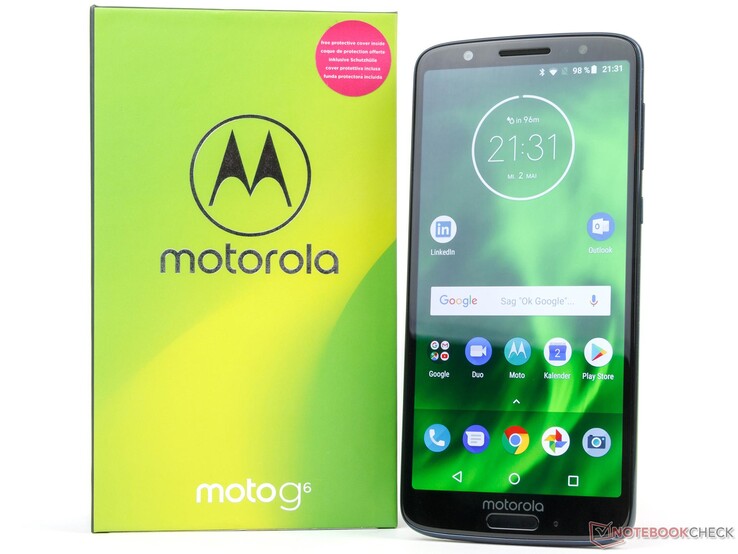
Size Comparison
❌
Features - Moto smartphone with USB Type-C and radio
Our exam unit of measurement of the Motorola Moto G6 is a dual-SIM smartphone. It is a plus since the use of a second Nano-SIM card does non prevent you from using a microSD card. Storage cards are officially supported up to 128 GB. Since the SDXC standard has already produced larger models, those should also work without any trouble. However, you cannot format a microSD every bit an internal storage. Anyone needing to install and move apps onto the storage carte must first enable this in the developer options.
Every bit one of the few smartphones of its cost range, information technology already has a Blazon-C USB connection. This still transfers at the 2.0 standard and also masters OTG, so that external storage and input devices can also be connected to the Moto G6. In improver, the Motorola phone has an NFC bit, a radio receiver, also as Bluetooth 4.two with aptX HD support.
Software - Android 8.0 Oreo and useful features
Google Android 8.0 Oreo is used as the operating organisation. The manufacturer has only modified the visuals minimally. This is accompanied by the well-known Moto app, which offers suggestions for usage and boosted features such every bit gesture navigation, Moto Key, notification display, as well as its own voice navigation. While that does not run quite as fast equally Google Banana for instance, its privacy protection regulations are better defined. Lenovo claims that it will even keep the privacy protection standards when the information is transferred to countries that have lower legal standards. The voice recognition itself works quite reliably, but often needs a moment when a command should be implemented in an app. In addition, vocalization tin can as well be used to unlock the smartphone.
At the time of this test, the Google security patches are on the level of March ane, 2018 and thus adequately electric current. Another positive aspect is that the user account command is implemented in the system. Motorola has also preinstalled the LinkedIn and Microsoft Outlook apps, which tin be deactivated in the Settings, though.
Communication and GPS - Standstill since the Moto G5
The Snapdragon 450 in the Motorola Moto G6 has a Qualcomm X9-LTE modem on board, which nominally would be able to support LTE Cat. 7. Nonetheless, Lenovo has decided to only offering LTE Cat. 4, which enables a maximum of 150 MBit/southward during downloads and 50 MBit/s during uploads. Although this is completely sufficient for everyday life and offers quite a wide support of frequency bands, the providers already support college transfer rates. The mobile reception was inconspicuous in the mature net of a large metropolis.
The WLAN module of the Moto G6 masters the IEEE-802.xi a/b/m/n standards and is able to utilise the ii.4 as well equally the 5.0-GHz net. While the transfer rates to our Linksys EA8500 reference router are slightly to a higher place the average, the range of the WLAN connection is non very far. Fifty-fifty a few meters from the router, downloads take noticeably longer and the reaction times also become slower. If there is a wall between the smartphone and the Access Point, it can happen that the connection drops entirely.
| Networking | |
| iperf3 Client (transmit) 1 m 4M x10 Netgear AX12 | |
| Average of grade Smartphone (5.59 - 1599, n=255, final 2 years) | |
| Nokia six 2018 | |
| Samsung Milky way J7 2017 | |
| BQ Aquaris X Pro | |
| Motorola Moto G6 | |
| Motorola Moto G5s | |
| Honor ix Low-cal | |
| ZTE Blade V9 | |
| iperf3 Client (receive) 1 m 4M x10 Netgear AX12 | |
| Average of class Smartphone (xv.five - 1414, north=255, concluding 2 years) | |
| Nokia 6 2018 | |
| Samsung Galaxy J7 2017 | |
| BQ Aquaris X Pro | |
| Motorola Moto G5s | |
| Motorola Moto G6 | |
| Honor 9 Lite | |
| ZTE Blade V9 | |
The Lenovo smartphone supports the GPS, GLONASS, and BeiDou satellite networks. To fix on a satellite already takes virtually five seconds outdoors, which is relatively long. On the other hand, it is authentic up to iii meters (ten ft). Indoors, this can take more than than one-and-a-one-half minutes, and the location accuracy then varies betwixt 65 and 258 meters (~230-836 ft).
While this does not brand usa specially optimistic for the practise test on the bicycle, the Motorola phone positively surprises the states and is able to quite convince us with its recorded route. Even if it does not always stay exactly on the traversed road, it nonetheless offers a more than decent performance and in parts is fifty-fifty more accurate than the Garmin Edge 500.
Telephone Functions and Voice Quality
Equally telephone app, the Moto G6 as well uses the standard app from Google, which offers the usual comfort and clear overview.
We like the phone call qualities of the Motorola smartphone very much, and the three microphones ensure an effective noise suppression fifty-fifty when using the speaker way. The voice quality is likewise very adept. Holding information technology to your ear, your voice also as that of your chat partner are transferred clearly. Only when using the speaker, the vox of the G6 user is echoing slightly. However, you can notwithstanding hear it well if the speaker sits at a little altitude from the phone and does not speak too quietly.
The Moto G6 supports VoLTE as well as VoWifi.
Cameras - The dual photographic camera of the Moto Chiliad convinces

Compared to the Moto G5s, the front camera has improved and now offers 8 Megapixels. Added to this are a Dazzler Style and even an LED light in font for dark surroundings. Videos can exist recorded at 1080p (30 FPS) at all-time and are not stabilized. The picture quality is quite decent and the beautification of the subject is not exaggerated.
Different its predecessor, the Moto G6 now uses a dual photographic camera. The second camera serves to create pictures with Bokeh effects. While the resolution of the main camera has decreased to 12 MP, the camera is now more light sensitive with an discontinuity of f/1.8. The strength of the Bokeh upshot tin exist controlled via an onscreen slider. Anyone who exaggerates this will go a very blurry picture in virtually cases. Most of the time, fifty% or less is entirely sufficient and produce a presentable effect.
Nosotros similar the photographic camera performance during daylight. Due to the automatic HDR mode, you can easily produce pictures that accept a relatively high dynamic range, and the reproduced colors are stiff and saturated. Competitors such as the Galaxy J7 or the Accolade 9 Lite cannot quite proceed upwards with this. Nonetheless, there is a small hitch, since the shutter speed of the Moto G6 is relatively dull. With moving targets in detail, some pictures go amiss. In weak light conditions, the colors of the pictures appear slightly slow. Yet, the degree of particular is the highest of the comparison field and considering its toll range, the Motorola smartphone does adequately well.
Videos are recorded at a maximum of Total HD with up to 60 images per 2nd. However, we do not recommend this, since you can then already run across some minor artifacts on the screen. In addition, prototype stabilization is only available up to thirty FPS. The sound is recorded in stereo, and the racket level is relatively low.
Epitome Comparison
Cull a scene and navigate inside the first epitome. 1 click changes the position on touchscreens. One click on the zoomed-in image opens the original in a new window. The first image shows the scaled photograph of the test device.
Scene 1Scene 2Scene 3

click to load images

click to load images

click to load images

Motorola Moto G6: Image taken with master photographic camera (portrait way) full resolution

Motorola Moto G6: Paradigm taken with main camera while driving full resolution
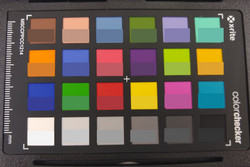
Nosotros perform further tests of the dual camera of the Moto G6 under controlled light weather. The ColorChecker shows the stronger saturation of the reproduced colors well. In addition, they are slightly brightened, and the skin tones show a slight red tint.
In the directly comparison of the reproduction in the center of the image, the Motorola smartphone as well shows a good functioning, and only the Galaxy J7 is able to reproduce the details fifty-fifty amend. When looking at the test nautical chart as a whole, the Moto G6 also delivers a decent operation. However, the colour transitions show pocket-sized artifacts, and the edges of the letters easily become rather frayed.
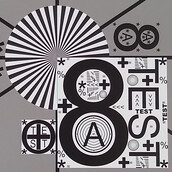
Moto G6
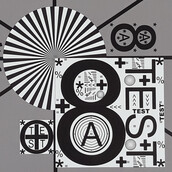
Galaxy J7

Honor 9 Lite
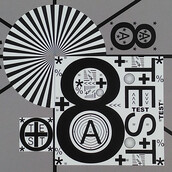
Blade V9

Accessories and Warranty
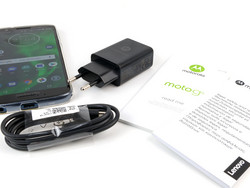
The Motorola Moto G6 comes with a modular fast-charger (5 V, 3 A; 9 V, 1.6 A; 12 V, 1.2 A), a USB cable (Blazon-A to Type-C), a tool to open the carte tray, a gel comprehend, a Quick Beginning Guide, and a warranty booklet.
Anyone ordering directly from Motorola will too receive a wireless Motorola Pulse Escape+ headset. However, this campaign is accompanied by the proclamation, "as long as it is in stock," so information technology may non exist available for long.
Motorola offers 24 months of warranty for the smartphone. Please see ourGuarantees, Render policies and Warranties FAQ for country-specific information.
Input Devices and Operation
The capacitive touchscreen of the Motorola Moto G6 recognizes up to x simultaneous touch on points. The Corning Gorilla Glass 3 surface offers good sliding characteristics and reacts to input quickly and precisely. Google'southward GBoard is preinstalled as the standard keyboard layout. If necessary, this can be easily replaced by some other layout from the Play Shop.
The fingerprint sensor on the front recognizes the saved fingerprints reliably and after unlocking the phone,straight brings the user to the habitation screen or the still open app. Furthermore, the sensor can also replace the Android onscreen keys via using gestures. While we would recommend against using unlocking via vocalisation since it can be hands circumvented, information technology worked quite reliably during our test. In addition, you can utilize face up recognition. Even in good light weather, this takes a long second to unlock the smartphone, and in some cases just did nothing. In the night, it did not piece of work at all, since the lite of the display is apparently not sufficient to recognize the user.
Display - Smartphone with a bright IPS display
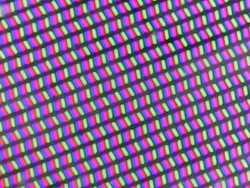
The Motorola Moto G6 is the first smartphone of the Moto-G series that is equipped with a display in the 2:1 format. It measures 5.7 inches (xiv.48 cm) and with that is nominally 0.v inches larger than the panel of the Moto G5s. Due to the change of the format ratio, the actual proceeds in brandish surface turns out lower than suggested as you tin can see in the tabular array.
At this indicate, the resolution of 2160x1080 pixels corresponds to the standard in this device grade, delivering a high pixel density and sharpness. The brightness of the display is skillful and too at the level typical for the toll range. With the brightness sensor activated, nosotros tin even measure 612 cd/grand² in the centre of the display. If the brightness is measured with an fifty-fifty distribution of brilliant and dark areas, the effulgence drops by well-nigh 30 cd/m².
While the black value is decent, black areas announced more similar night gray. In this respect, the Milky way J7 has an advantage with its Super AMOLED panel, which tin reproduce absolute black. However, at 1162:1 the IPS-display of the Moto G6 nevertheless achieves a skillful dissimilarity ratio.
The manufacturer uses Pulse Width Modulation to dim the brandish, merely since its frequency is extremely high, nearly users will non exist disturbed by it or even be able to perceive it. In that location is likewise a blueish light filter to protect the eyes when using information technology late at nighttime.
| Model | Moto G6 | Moto G5s | Nokia 6 | 5.7 in (16:nine) |
|---|---|---|---|---|
| Display area | 83.84 cm² (13 in²) | 74.54 cm² (xi.5 in²) | 83.39 cm² (12.9 in²) | 89.57 cm² (13.9 in²) |
| 462 cd/chiliad² | 486 cd/yard² | 477 cd/thou² | ||
| 475 cd/1000² | 488 cd/m² | 473 cd/m² | ||
| 471 cd/m² | 480 cd/grand² | 486 cd/m² | ||
Distribution of brightness
X-Rite i1Pro 2
Maximum: 488 cd/m² (Nits) Average: 477.6 cd/one thousand² Minimum: 12.96 cd/thou²
Effulgence Distribution: 95 %
Centre on Bombardment: 488 cd/m²
Contrast: 1162:1 (Black: 0.42 cd/m²)
ΔE Color three.9 | 0.59-29.43 Ø5.four
ΔE Greyscale 5.iii | 0.64-98 Ø5.6
94.8% sRGB (Calman 2d)
Gamma: 2.41
| Motorola Moto G6 IPS, 2160x1080, 5.70 | Motorola Moto G5s IPS, 1920x1080, 5.20 | ZTE Blade V9 IPS, 2160x1080, five.70 | Honour nine Calorie-free IPS, 2160x1080, five.65 | Nokia six 2018 IPS, 1920x1080, 5.50 | Samsung Milky way J7 2017 Super AMOLED, 1920x1080, 5.fifty | BQ Aquaris X Pro IPS, 1920x1080, v.20 | |
|---|---|---|---|---|---|---|---|
| Screen | -7% | -15% | viii% | -34% | 20% | -44% | |
| Effulgence middle | 488 | 490 0% | 459 -6% | 627 28% | 417 -15% | 454 -7% | 458 -6% |
| Effulgence | 478 | 502 5% | 437 -9% | 622 30% | 421 -12% | 463 -3% | 473 -i% |
| Effulgence Distribution | 95 | 92 -three% | 90 -5% | 82 -14% | 88 -7% | 86 -ix% | 88 -vii% |
| Blackness Level * | 0.42 | 0.43 -2% | 0.62 -48% | 0.41 2% | 0.61 -45% | 0.51 -21% | |
| Contrast | 1162 | 1140 -2% | 740 -36% | 1529 32% | 684 -41% | 898 -23% | |
| Colorchecker dE 2000 * | 3.9 | 5.7 -46% | 4.5 -15% | 4.5 -15% | 6.1 -56% | 2 49% | vii.1 -82% |
| Colorchecker dE 2000 max. * | half dozen.8 | 7.viii -15% | seven.3 -7% | 7 -iii% | xi.two -65% | 5.3 22% | 14.5 -113% |
| Greyscale dE 2000 * | 5.3 | 4.7 eleven% | 4.9 8% | five.1 4% | vii.1 -34% | 1.7 68% | 10.five -98% |
| Gamma | 2.41 91% | 2.4 92% | 2.17 101% | 2.26 97% | 2.16 102% | ii.one 105% | ii.28 96% |
| CCT | 7146 91% | 7526 86% | 7261 90% | 7201 90% | 8362 78% | 6394 102% | 8951 73% |
* ... smaller is better
Screen Flickering / PWM (Pulse-Width Modulation)
ℹ
To dim the screen, some notebooks will simply bicycle the backlight on and off in rapid succession - a method called Pulse Width Modulation (PWM) . This cycling frequency should ideally be undetectable to the human eye. If said frequency is as well low, users with sensitive optics may experience strain or headaches or even notice the flickering altogether.
| Screen flickering / PWM detected | 2315 Hz | ≤ 17 % effulgence setting | 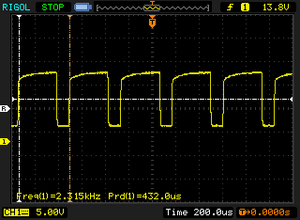 |
| The brandish backlight flickers at 2315 Hz (Likely utilizing PWM) Flickering detected at a brightness setting of 17 % and beneath. There should be no flickering or PWM above this brightness setting. The frequency of 2315 Hz is quite high, so nigh users sensitive to PWM should not notice whatsoever flickering. In comparison: 52 % of all tested devices do not use PWM to dim the brandish. If PWM was detected, an average of 22039 (minimum: v - maximum: 3846000) Hz was measured. | |||
We evaluate the color reproduction of the Moto G6 display with a photograph spectrometer and the CalMAN analysis software. The smartphone offers dissimilar setting options which give the user the choice betwixt a Normal and an Intensive mode. In addition, the color temperature can exist adjusted to Warm, Neutral, or Absurd. The default settings are Intensive/Neutral, which displays the contents in a very cool presentation, causing visible color deviations due to oversaturation. Anyone wanting a more than accurate colour reproduction on the display should choose the Normal/Warm settings. Even then, the presentation is all the same a bit too cool, but visibly more pleasant and the deviations are not quite as grave. The smartphone uses the sRGB colour space, without fully roofing information technology, yet.
Display Response Times
ℹ
Display response times bear witness how fast the screen is able to change from one color to the next. Slow response times can lead to afterimages and tin can crusade moving objects to announced blurry (ghosting). Gamers of fast-paced 3D titles should pay special attention to fast response times.
| ↔ Response Time Blackness to White | ||
|---|---|---|
| 24 ms ... ascent ↗ and fall ↘ combined | ↗ 12.4 ms rise | 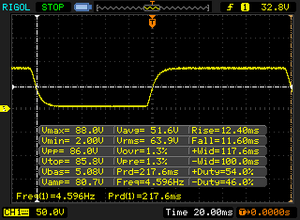 |
| ↘ 11.6 ms fall | ||
| The screen shows expert response rates in our tests, but may exist besides tedious for competitive gamers. In comparing, all tested devices range from 0.8 (minimum) to 240 (maximum) ms. » 40 % of all devices are meliorate. This means that the measured response fourth dimension is like to the average of all tested devices (23.v ms). | ||
| ↔ Response Time fifty% Gray to 80% Grayness | ||
| 37.2 ms ... rising ↗ and fall ↘ combined | ↗ 18 ms rise | 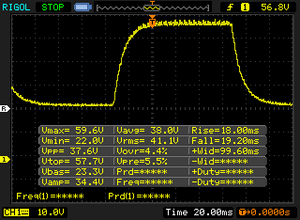 |
| ↘ 19.two ms fall | ||
| The screen shows ho-hum response rates in our tests and volition exist unsatisfactory for gamers. In comparison, all tested devices range from 0.692 (minimum) to 636 (maximum) ms. » 40 % of all devices are better. This means that the measured response time is similar to the boilerplate of all tested devices (37.i ms). | ||
Outdoors, the Motorola Moto G6 benefits from its bright display, as long as the brightness sensor is activated. Although it always needs a brusque moment to adjust to a new lite status, information technology does its work reliably. Thus the contents still remain hands readable in very vivid environs. Only the very reflective surface of the display makes it difficult to see anything in straight sunlight.
The viewing bending stability of the IPS display in the Motorola Moto G6 is very good. We did not discover whatsoever colour distortions, and also the glow event that is typical for the IPS technology can but exist noticeable in very steep viewing angles.
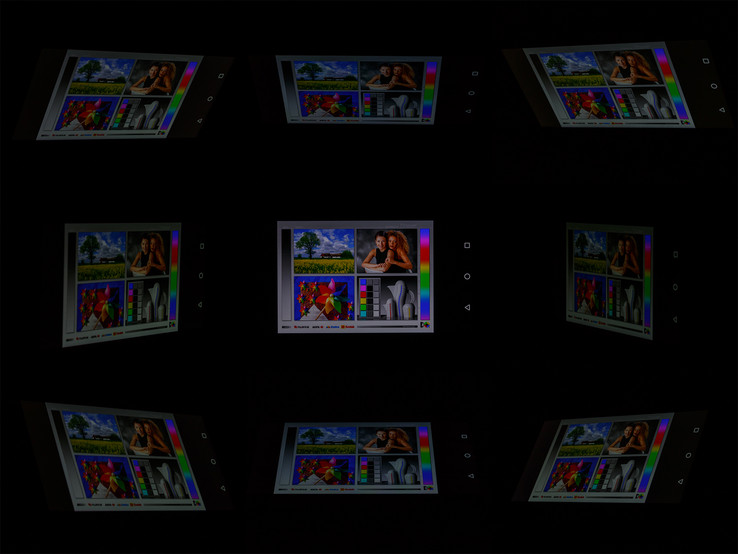
Operation – Moto smartphone with the new Snapdragon 450
The Motorola Moto G6 uses the new Snapdragon 450, which has replaced its predecessor, the Snapdragon 430 from the Moto G5s. The big difference lies mainly in the manufacturing process. While the 430 series is still manufactured in the 28-nm size process, the new 450 uses xiv nm. Correspondingly, the clock speed of the eight Cortex-A53 cores can exist increased past 400 MHz to i.eight GHz, which is accompanied by a decent functioning increase. The GPU now comes from Qualcomm'southward Snapdragon 600 series and provides the G6 with an Adreno 506, which is also used in the Snapdragon 626 among others. This is accompanied by iii GB of working memory.
In the benchmarks, the Moto G6 delivers a decent performance that is at the same level as that of the ZTE Blade V9 which uses the same SoC. While at eighteen percent, the performance increase in the single core area is non quite as loftier every bit expected, it turns out significantly higher when using all the cores, increasing past seventy percent compared to the Moto G5s. The performance increase in the graphics benchmarks varies between 30 and lx per centum. The arrangement operation is not simply loftier subjectively, simply near approaches the level of a Snapdragon 630 in the PCMark.
| AnTuTu v6 - Total Score (sort by value) | |
| Motorola Moto G6 | |
| Motorola Moto G5s | |
| ZTE Blade V9 | |
| Award nine Lite | |
| Nokia half-dozen 2018 | |
| Samsung Galaxy J7 2017 | |
| BQ Aquaris 10 Pro | |
| Average Qualcomm Snapdragon 450 (54731 - 60077, n=ten) | |
| AnTuTu v7 | |
| Total Score (sort past value) | |
| Motorola Moto G6 | |
| ZTE Bract V9 | |
| Honor 9 Light | |
| Nokia 6 2018 | |
| Samsung Galaxy J7 2017 | |
| BQ Aquaris X Pro | |
| Average Qualcomm Snapdragon 450 (56497 - 73468, n=11) | |
| CPU (sort by value) | |
| Motorola Moto G6 | |
| ZTE Blade V9 | |
| Honor 9 Lite | |
| Nokia 6 2018 | |
| Samsung Milky way J7 2017 | |
| BQ Aquaris X Pro | |
| Average Qualcomm Snapdragon 450 (33473 - 35092, n=xi) | |
| PCMark for Android | |
| Work functioning score (sort by value) | |
| Motorola Moto G6 | |
| Motorola Moto G5s | |
| ZTE Blade V9 | |
| Honor ix Lite | |
| Nokia half dozen 2018 | |
| Samsung Milky way J7 2017 | |
| BQ Aquaris 10 Pro | |
| Average Qualcomm Snapdragon 450 (4836 - 6062, n=14) | |
| Average of class Smartphone (3341 - 19989, due north=139, last 2 years) | |
| Work 2.0 functioning score (sort by value) | |
| Motorola Moto G6 | |
| Motorola Moto G5s | |
| ZTE Bract V9 | |
| Honor 9 Lite | |
| Nokia 6 2018 | |
| Samsung Galaxy J7 2017 | |
| BQ Aquaris Ten Pro | |
| Boilerplate Qualcomm Snapdragon 450 (4171 - 4759, north=14) | |
| Average of class Smartphone (82 - 15299, n=187, concluding 2 years) | |
| BaseMark Os Ii | |
| Overall (sort by value) | |
| Motorola Moto G6 | |
| Motorola Moto G5s | |
| ZTE Blade V9 | |
| Honor ix Lite | |
| Nokia 6 2018 | |
| Samsung Galaxy J7 2017 | |
| BQ Aquaris X Pro | |
| Boilerplate Qualcomm Snapdragon 450 (389 - 1337, n=xiv) | |
| Average of class Smartphone (615 - 8124, n=193, last 2 years) | |
| Organization (sort by value) | |
| Motorola Moto G6 | |
| Motorola Moto G5s | |
| ZTE Blade V9 | |
| Honor ix Lite | |
| Nokia 6 2018 | |
| Samsung Milky way J7 2017 | |
| BQ Aquaris 10 Pro | |
| Average Qualcomm Snapdragon 450 (2560 - 2898, due north=fourteen) | |
| Average of grade Smartphone (1160 - 19657, n=193, last two years) | |
| Memory (sort by value) | |
| Motorola Moto G6 | |
| Motorola Moto G5s | |
| ZTE Blade V9 | |
| Honor nine Lite | |
| Nokia 6 2018 | |
| Samsung Milky way J7 2017 | |
| BQ Aquaris X Pro | |
| Average Qualcomm Snapdragon 450 (770 - 1522, n=fourteen) | |
| Average of course Smartphone (522 - 9044, northward=193, final 2 years) | |
| Graphics (sort by value) | |
| Motorola Moto G6 | |
| Motorola Moto G5s | |
| ZTE Blade V9 | |
| Honour nine Lite | |
| Nokia 6 2018 | |
| Samsung Galaxy J7 2017 | |
| BQ Aquaris X Pro | |
| Average Qualcomm Snapdragon 450 (943 - 984, n=14) | |
| Average of class Smartphone (349 - 25642, n=193, last 2 years) | |
| Web (sort by value) | |
| Motorola Moto G6 | |
| Motorola Moto G5s | |
| ZTE Blade V9 | |
| Honour 9 Lite | |
| Nokia six 2018 | |
| Samsung Galaxy J7 2017 | |
| BQ Aquaris X Pro | |
| Average Qualcomm Snapdragon 450 (10 - 981, n=fourteen) | |
| Average of class Smartphone (679 - 2392, northward=193, concluding 2 years) | |
| Geekbench 4.1 - 4.4 | |
| 64 Fleck Single-Core Score (sort by value) | |
| Motorola Moto G6 | |
| Motorola Moto G5s | |
| ZTE Blade V9 | |
| Honor nine Lite | |
| Nokia half-dozen 2018 | |
| Samsung Galaxy J7 2017 | |
| BQ Aquaris 10 Pro | |
| Average Qualcomm Snapdragon 450 (741 - 787, n=thirteen) | |
| Average of class Smartphone (606 - 6984, north=65, final two years) | |
| 64 Fleck Multi-Core Score (sort by value) | |
| Motorola Moto G6 | |
| Motorola Moto G5s | |
| ZTE Blade V9 | |
| Honor ix Lite | |
| Nokia six 2018 | |
| Samsung Galaxy J7 2017 | |
| BQ Aquaris 10 Pro | |
| Average Qualcomm Snapdragon 450 (3272 - 4022, n=13) | |
| Boilerplate of class Smartphone (1556 - 15310, n=65, concluding 2 years) | |
| Compute RenderScript Score (sort by value) | |
| Motorola Moto G6 | |
| Motorola Moto G5s | |
| ZTE Blade V9 | |
| Honor 9 Calorie-free | |
| Nokia half dozen 2018 | |
| Samsung Galaxy J7 2017 | |
| Average Qualcomm Snapdragon 450 (2777 - 3374, n=10) | |
| Average of class Smartphone (2810 - 11362, n=52, last ii years) | |
| 3DMark | |
| 1280x720 offscreen Ice Tempest Unlimited Score (sort by value) | |
| Motorola Moto G6 | |
| Motorola Moto G5s | |
| ZTE Blade V9 | |
| Honor 9 Low-cal | |
| Nokia six 2018 | |
| Samsung Galaxy J7 2017 | |
| BQ Aquaris 10 Pro | |
| Average Qualcomm Snapdragon 450 (12562 - 13203, n=12) | |
| Average of form Smartphone (2920 - 117606, n=128, last 2 years) | |
| 1280x720 offscreen Ice Storm Unlimited Graphics Score (sort by value) | |
| Motorola Moto G6 | |
| Motorola Moto G5s | |
| ZTE Blade V9 | |
| Honor 9 Light | |
| Nokia half dozen 2018 | |
| Samsung Galaxy J7 2017 | |
| BQ Aquaris 10 Pro | |
| Average Qualcomm Snapdragon 450 (12281 - 12736, n=12) | |
| Average of class Smartphone (2463 - 224130, north=128, last two years) | |
| 1280x720 offscreen Ice Tempest Unlimited Physics (sort past value) | |
| Motorola Moto G6 | |
| Motorola Moto G5s | |
| ZTE Blade V9 | |
| Honor nine Light | |
| Nokia vi 2018 | |
| Samsung Milky way J7 2017 | |
| BQ Aquaris X Pro | |
| Boilerplate Qualcomm Snapdragon 450 (13596 - 15273, n=12) | |
| Boilerplate of form Smartphone (8324 - 59268, northward=128, terminal two years) | |
| 2560x1440 Sling Shot OpenGL ES iii.0 (sort by value) | |
| Motorola Moto G6 | |
| Motorola Moto G5s | |
| ZTE Blade V9 | |
| Laurels 9 Lite | |
| Nokia half dozen 2018 | |
| Samsung Milky way J7 2017 | |
| BQ Aquaris 10 Pro | |
| Average Qualcomm Snapdragon 450 (800 - 829, n=fourteen) | |
| Average of class Smartphone (68 - 11256, northward=211, last 2 years) | |
| 2560x1440 Sling Shot OpenGL ES iii.0 Graphics (sort by value) | |
| Motorola Moto G6 | |
| Motorola Moto G5s | |
| ZTE Blade V9 | |
| Honor nine Light | |
| Nokia half dozen 2018 | |
| Samsung Milky way J7 2017 | |
| BQ Aquaris X Pro | |
| Average Qualcomm Snapdragon 450 (690 - 716, northward=14) | |
| Average of course Smartphone (54 - 16670, n=211, last two years) | |
| 2560x1440 Sling Shot OpenGL ES three.0 Physics (sort by value) | |
| Motorola Moto G6 | |
| Motorola Moto G5s | |
| ZTE Blade V9 | |
| Accolade 9 Calorie-free | |
| Nokia half-dozen 2018 | |
| Samsung Milky way J7 2017 | |
| BQ Aquaris 10 Pro | |
| Average Qualcomm Snapdragon 450 (1504 - 1901, n=14) | |
| Average of form Smartphone (677 - 5301, due north=211, last 2 years) | |
| 2560x1440 Sling Shot Extreme (ES 3.1) (sort by value) | |
| Motorola Moto G6 | |
| Motorola Moto G5s | |
| ZTE Bract V9 | |
| Honor 9 Low-cal | |
| Nokia 6 2018 | |
| Samsung Galaxy J7 2017 | |
| BQ Aquaris X Pro | |
| Average Qualcomm Snapdragon 450 (438 - 449, n=14) | |
| Boilerplate of class Smartphone (78 - 9138, north=207, terminal 2 years) | |
| 2560x1440 Sling Shot Extreme (ES three.one) Graphics (sort by value) | |
| Motorola Moto G6 | |
| Motorola Moto G5s | |
| ZTE Blade V9 | |
| Honor 9 Calorie-free | |
| Nokia 6 2018 | |
| Samsung Galaxy J7 2017 | |
| BQ Aquaris Ten Pro | |
| Boilerplate Qualcomm Snapdragon 450 (349 - 382, due north=fourteen) | |
| Average of class Smartphone (62 - 11573, north=207, concluding ii years) | |
| 2560x1440 Sling Shot Extreme (ES three.1) Physics (sort past value) | |
| Motorola Moto G6 | |
| Motorola Moto G5s | |
| ZTE Blade V9 | |
| Honor 9 Lite | |
| Nokia 6 2018 | |
| Samsung Galaxy J7 2017 | |
| BQ Aquaris Ten Pro | |
| Average Qualcomm Snapdragon 450 (1521 - 1860, n=fourteen) | |
| Average of grade Smartphone (688 - 5318, northward=207, last 2 years) | |
| GFXBench (DX / GLBenchmark) 2.seven | |
| T-Rex Onscreen (sort by value) | |
| Motorola Moto G6 | |
| Motorola Moto G5s | |
| ZTE Bract V9 | |
| Honor 9 Lite | |
| Nokia 6 2018 | |
| Samsung Galaxy J7 2017 | |
| BQ Aquaris X Pro | |
| Average Qualcomm Snapdragon 450 (xx - 34, n=13) | |
| Average of grade Smartphone (9.v - 143, north=215, last 2 years) | |
| 1920x1080 T-King Offscreen (sort by value) | |
| Motorola Moto G6 | |
| Motorola Moto G5s | |
| ZTE Bract V9 | |
| Laurels ix Light | |
| Nokia half dozen 2018 | |
| Samsung Galaxy J7 2017 | |
| BQ Aquaris X Pro | |
| Average Qualcomm Snapdragon 450 (21 - 23, n=13) | |
| Boilerplate of class Smartphone (half-dozen - 428, due north=215, last 2 years) | |
| GFXBench 3.0 | |
| on screen Manhattan Onscreen OGL (sort by value) | |
| Motorola Moto G6 | |
| Motorola Moto G5s | |
| ZTE Bract V9 | |
| Honor nine Lite | |
| Nokia half dozen 2018 | |
| Samsung Milky way J7 2017 | |
| BQ Aquaris Ten Pro | |
| Average Qualcomm Snapdragon 450 (8.7 - 18, north=13) | |
| Boilerplate of class Smartphone (4.v - 121, n=214, final 2 years) | |
| 1920x1080 1080p Manhattan Offscreen (sort by value) | |
| Motorola Moto G6 | |
| Motorola Moto G5s | |
| ZTE Bract V9 | |
| Honor 9 Calorie-free | |
| Nokia vi 2018 | |
| Samsung Galaxy J7 2017 | |
| BQ Aquaris Ten Pro | |
| Boilerplate Qualcomm Snapdragon 450 (9.ii - 9.4, northward=13) | |
| Average of grade Smartphone (1 - 251, n=216, last ii years) | |
| GFXBench 3.1 | |
| on screen Manhattan ES 3.1 Onscreen (sort past value) | |
| Motorola Moto G6 | |
| Motorola Moto G5s | |
| ZTE Blade V9 | |
| Honor nine Light | |
| Nokia vi 2018 | |
| Samsung Galaxy J7 2017 | |
| BQ Aquaris Ten Pro | |
| Average Qualcomm Snapdragon 450 (5.7 - 13, n=xiii) | |
| Average of class Smartphone (three.ane - 121, north=213, last 2 years) | |
| 1920x1080 Manhattan ES iii.one Offscreen (sort by value) | |
| Motorola Moto G6 | |
| Motorola Moto G5s | |
| ZTE Blade V9 | |
| Honor 9 Lite | |
| Nokia vi 2018 | |
| Samsung Galaxy J7 2017 | |
| BQ Aquaris 10 Pro | |
| Average Qualcomm Snapdragon 450 (6 - six.9, n=13) | |
| Boilerplate of course Smartphone (one.4 - 169, n=214, terminal ii years) | |
| GFXBench | |
| on screen Machine Hunt Onscreen (sort by value) | |
| Motorola Moto G6 | |
| Motorola Moto G5s | |
| ZTE Blade V9 | |
| Honor 9 Light | |
| Nokia 6 2018 | |
| Samsung Galaxy J7 2017 | |
| BQ Aquaris X Pro | |
| Average Qualcomm Snapdragon 450 (3.3 - 7, n=13) | |
| Boilerplate of class Smartphone (3.iii - 81, northward=213, final two years) | |
| 1920x1080 Car Chase Offscreen (sort past value) | |
| Motorola Moto G6 | |
| Motorola Moto G5s | |
| ZTE Blade V9 | |
| Honor ix Lite | |
| Nokia half dozen 2018 | |
| Samsung Galaxy J7 2017 | |
| BQ Aquaris X Pro | |
| Average Qualcomm Snapdragon 450 (3.iii - iii.6, n=13) | |
| Average of class Smartphone (ane.eight - 96.half dozen, n=213, terminal 2 years) | |
Legend
Motorola Moto G5s Qualcomm Snapdragon 430 (MSM8937), Qualcomm Adreno 505, 32 GB eMMC Wink
ZTE Blade V9 Qualcomm Snapdragon 450, Qualcomm Adreno 506, 32 GB eMMC Flash
Honor nine Light HiSilicon Kirin 659, ARM Mali-T830 MP2, 32 GB eMMC Flash
Nokia 6 2018 Qualcomm Snapdragon 630, Qualcomm Adreno 508, 32 GB eMMC Wink
Using the preinstalled Chrome 66 browser, you tin surf quite fast on the web. In the benchmarks, the Moto G6 is at the same level as the ZTE Bract V9 and is only browbeaten by the competitors with stronger SoCs.
| JetStream 1.1 - Total Score | |
| Average of class Smartphone (10.8 - 414, n=198, last 2 years) | |
| Nokia 6 2018 (Browser: Chrome 65) | |
| BQ Aquaris Ten Pro (Chrome 59.0.3071.125) | |
| Honor nine Lite (Chrome 63) | |
| Samsung Galaxy J7 2017 (Samsung Browser 5.iv) | |
| Motorola Moto G6 (Chrome 66) | |
| Average Qualcomm Snapdragon 450 (22 - 22.7, n=13) | |
| ZTE Blade V9 (Ume Browser 1.2.18) | |
| Motorola Moto G5s (Chrome 62) | |
| Octane V2 - Total Score | |
| Average of course Smartphone (1986 - 65969, n=206, last 2 years) | |
| Nokia vi 2018 (Browser: Chrome 65) | |
| Honor 9 Lite (Chrome 63) | |
| Samsung Galaxy J7 2017 (Samsung Browser 5.4) | |
| BQ Aquaris X Pro (Chrome 59.0.3071.125) | |
| Average Qualcomm Snapdragon 450 (3470 - 4115, due north=14) | |
| ZTE Blade V9 (Ume Browser 1.2.eighteen) | |
| Motorola Moto G6 (Chrome 66) | |
| Motorola Moto G5s (Chrome 62) | |
| Mozilla Kraken one.1 - Total Score | |
| Motorola Moto G5s (Chrome 62) | |
| ZTE Blade V9 (Ume Browser ane.ii.18) | |
| Motorola Moto G6 (Chrome 66) | |
| Average Qualcomm Snapdragon 450 (11012 - 11863, northward=14) | |
| Honor 9 Lite (Chrome 63) | |
| Nokia 6 2018 (Browser: Chrome 65) | |
| BQ Aquaris X Pro (Chrome 59.0.3071.125) | |
| Samsung Galaxy J7 2017 (Samsung Browser 5.4) | |
| Average of grade Smartphone (414 - 29635, due north=208, terminal 2 years) | |
| WebXPRT 2015 - Overall Score | |
| Average of class Smartphone (166 - 285, n=8, last ii years) | |
| Nokia half-dozen 2018 | |
| Honor 9 Low-cal (Chrome 63) | |
| Average Qualcomm Snapdragon 450 (90 - 103, northward=seven) | |
| ZTE Blade V9 (Ume Browser 1.ii.eighteen) | |
| Motorola Moto G6 (Chrome 66) | |
| BQ Aquaris X Pro (Chrome 59.0.3071.125) | |
| Samsung Galaxy J7 2017 (Samsung Browser five.4) | |
| Motorola Moto G5s (Chrome 62) | |
* ... smaller is better
In straight comparison, the 32 GB eMMC storage of the Motorola Moto G6 is relatively fast and merely beaten past the Laurels 9 Lite. After the showtime startup, at that place is yet 25.35 GB of bachelor storage for the user, since the firmware together with the preinstalled apps use but half-dozen.65 GB.
We test the speed of the microSD card slot with our Toshiba Exceria Pro M501 reference card (max. read: 270 MB/southward, write: 150 MB/s). Even though the transfer rates are decent, the potential of the storage card is not fully used and the Moto G6 comes in last in the comparison field in this discipline.
| Motorola Moto G6 | Motorola Moto G5s | ZTE Blade V9 | Honor 9 Lite | Samsung Galaxy J7 2017 | BQ Aquaris Ten Pro | Average 32 GB eMMC Flash | Boilerplate of course Smartphone | |
|---|---|---|---|---|---|---|---|---|
| AndroBench 3-5 | -thirteen% | -19% | 11% | -35% | -18% | -23% | 135% | |
| Sequential Read 256KB | 238.ii | 259 9% | 265.4 xi% | 269.half dozen xiii% | 198.v -17% | 270.5 14% | 240 ? 1% | 884 ? 271% |
| Sequential Write 256KB | 117.2 | 77.5 -34% | 119.4 2% | 138.2 18% | 53 -55% | 139.6 xix% | 98.2 ? -16% | 425 ? 263% |
| Random Read 4KB | 69.9 | 40.half dozen -42% | 29.81 -57% | 68.four -2% | 25.86 -63% | 37.97 -46% | 42.three ? -39% | 156.9 ? 124% |
| Random Write 4KB | 59.9 | 46.ii -23% | 12.47 -79% | 66.8 12% | 10.54 -82% | 12.07 -lxxx% | 20.half dozen ? -66% | 150.2 ? 151% |
| Sequential Read 256KB SDCard | 75.three ? | 84.i ? 12% | 83.9 ? 11% | 83.i ? ten% | 76.1 ? 1% | 78.7 ? 5% | 71.8 ? -v% | 77.6 ? 3% |
| Sequential Write 256KB SDCard | 61.v ? | 62.3 ? ane% | 62.1 ? 1% | 71.nine ? 17% | 63.nine ? 4% | 49.77 ? -19% | 52.9 ? -14% | 59.five ? -3% |
Games - Stronger than the Moto G5
The graphics acceleration in the Motorola Moto G six is handled by a Qualcomm Adreno 506, which has a nominal clock speed of up to 650 MHz, but according to the manufacturer specifications runs at just 600 MHz. However, the performance offered past the mid-range GPU is on the expected level. We evaluate the frame rates with GameBench using current games. The "Asphalt 8" racing game still runs to a large extent smoothly even at loftier details, which had not been the example with the Adreno 505 of the Moto G5. Simply there are besides some short drops with the new graphics unit of measurement, which show equally a brusque stutter in the game. With hardware intensive games in item such every bit "Loonshit of Valor" or "PUBG", this can get abrasive during the game, which points us towards using lowest graphic settings. We as well tested the game with medium settings, but unfortunately the frame rates are and then not recorded for some unknown reason. While you tin can keep to play, there are some noticeable stutters occasionally. For all three games, the load times are noticeably longer than in smartphones with more powerful SoCs.
In the test, the position sensor of the Moto G6 is fast to react and precise, and also the touchscreen gives no reason for complaint. Moreover, the speaker within the ear slice is positioned well, and then that it does not even get covered accidentally when things become hectic.
| Asphalt viii: Airborne | |||
| Settings | Value | ||
| high | 29 fps | ||
| very low | thirty fps | ||
| Arena of Valor | |||
| Settings | Value | ||
| min | 31 fps | ||
| loftier HD | 30 fps | ||
| PUBG Mobile | |||
| Settings | Value | ||
| Smoothen | 26 fps | ||
Emissions - Cool Moto smartphone with decent speakers
Temperature
The surface temperatures of the Motorola Moto G6 remain comfortably depression, and only a small area of the smartphone warms up to body temperature. Information technology is also positive that the values inappreciably increase during constant load.
With the aid of the GFXBench bombardment test, we evaluate the behavior of the SoC during prolonged load. But neither in the T-Rex examination scenario (OpenGL ES 2.0), nor in the more power hungry Manhattan test (OpenGL ES 3.i) does the Moto show any weaknesses, delivering an even performance constantly.
| |||||||||||||||||||||||||
| Maximum: 36.four °C = 98 F Average: 33 °C = 91 F | |||||||||||||||||||||||||
| |||||||||||||||||||||||||
| Maximum: 31.8 °C = 89 F Average: xxx.eight °C = 87 F | |||||||||||||||||||||||||
Ability Supply (max.) 24.six °C = 76 F | Room Temperature 20.6 °C = 69 F | Voltcraft IR-260
| |||||||||||||||||||||||||
| Maximum: 35.8 °C = 96 F Average: 32.3 °C = 90 F | |||||||||||||||||||||||||
| |||||||||||||||||||||||||
| Maximum: 31.3 °C = 88 F Average: 30.5 °C = 87 F | |||||||||||||||||||||||||
Power Supply (max.) 23.3 °C = 74 F | Room Temperature xx.6 °C = 69 F | Voltcraft IR-260
(±) The average temperature for the upper side under maximal load is 33 °C / 91 F, compared to the average of 32.8 °C / 91 F for the devices in the class Smartphone.
(+) The maximum temperature on the upper side is 36.four °C / 98 F, compared to the average of 35.1 °C / 95 F, ranging from 22 to 52.9 °C for the course Smartphone.
(+) The bottom heats up to a maximum of 31.8 °C / 89 F, compared to the average of 33.eight °C / 93 F
(±) In idle usage, the boilerplate temperature for the upper side is 32.iii °C / xc F, compared to the device boilerplate of 32.8 °C / 91 F.
Speakers
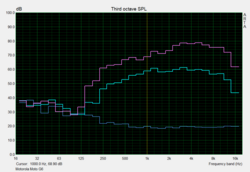
The speaker of the Moto G6 is located in the earpiece of the smartphone, so it does not go covered even when information technology is lying on the tabular array. At medium volume, it offers a relatively balanced and pleasant sound. Unfortunately, the Moto G6 is unable to maintain this at a high book, since the high notes become more prevalent then, causing information technology to sound tinny.
Despite having a USB Blazon-C, the Motorola smartphone still offers a headphone jack, which outputs the sound cleanly and with a low level of dissonance. The USB port offers no audio capabilities.
Frequency diagram (checkboxes tin be checked and unchecked to compare devices)
Motorola Moto G6 audio analysis
(+) | speakers tin can play relatively loud (87.4 dB)
Bass 100 - 315 Hz
(-) | nearly no bass - on average 21.4% lower than median
(±) | linearity of bass is average (12.7% delta to prev. frequency)
Mids 400 - 2000 Hz
(+) | balanced mids - simply 2.half dozen% away from median
(+) | mids are linear (4.iii% delta to prev. frequency)
Highs ii - xvi kHz
(±) | college highs - on average 8.3% higher than median
(+) | highs are linear (2.ix% delta to prev. frequency)
Overall 100 - 16.000 Hz
(±) | linearity of overall sound is average (19.2% divergence to median)
Compared to aforementioned class
» 17% of all tested devices in this class were better, 9% similar, 74% worse
» The all-time had a delta of 12%, average was 23%, worst was 65%
Compared to all devices tested
» 44% of all tested devices were better, vii% similar, 49% worse
» The best had a delta of 3%, average was xx%, worst was 65%
ZTE Blade V9 audio assay
(+) | speakers can play relatively loud (82.9 dB)
Bass 100 - 315 Hz
(-) | near no bass - on average 30.2% lower than median
(±) | linearity of bass is average (eleven% delta to prev. frequency)
Mids 400 - 2000 Hz
(+) | balanced mids - only 4.six% away from median
(+) | mids are linear (four.nine% delta to prev. frequency)
Highs 2 - xvi kHz
(±) | college highs - on average 7.7% college than median
(+) | highs are linear (2.iv% delta to prev. frequency)
Overall 100 - sixteen.000 Hz
(±) | linearity of overall sound is average (25.2% divergence to median)
Compared to same class
» 65% of all tested devices in this form were better, 10% similar, 26% worse
» The best had a delta of 12%, average was 23%, worst was 65%
Compared to all devices tested
» 78% of all tested devices were amend, 5% like, 17% worse
» The best had a delta of three%, average was xx%, worst was 65%
Samsung Galaxy J7 2017 audio analysis
(+) | speakers can play relatively loud (87.1 dB)
Bass 100 - 315 Hz
(-) | well-nigh no bass - on average 25.6% lower than median
(±) | linearity of bass is boilerplate (11.1% delta to prev. frequency)
Mids 400 - 2000 Hz
(+) | counterbalanced mids - only 3.2% away from median
(+) | mids are linear (4.4% delta to prev. frequency)
Highs two - 16 kHz
(±) | higher highs - on average 7.one% higher than median
(+) | highs are linear (4.5% delta to prev. frequency)
Overall 100 - 16.000 Hz
(±) | linearity of overall sound is boilerplate (21% difference to median)
Compared to same class
» 30% of all tested devices in this class were better, 12% like, 58% worse
» The best had a delta of 12%, boilerplate was 23%, worst was 65%
Compared to all devices tested
» 55% of all tested devices were better, 8% like, 37% worse
» The best had a delta of 3%, average was xx%, worst was 65%
Battery Life - Efficient smartphone with a good bombardment life
Energy Consumption
While the power consumption of the Motorola Moto G6 has improved particularly under load, at maximum brightness the new display draws more ability from the battery, which was to be expected due to the larger panel surface. However, the smartphone is more efficient than its predecessor, which tin can mainly be traced dorsum to the more than efficient Snapdragon processor.
The Moto G6 supports Motorola's TurboPower charging standard, which is based on USB-PD. The box includes the corresponding fast charger (fifteen watts). With it, the battery tin exist fully recharged inside 95 minutes, with fifty percentage being reached after 30 minutes, and 80 percent after 53 minutes.
| Motorola Moto G6 3000 mAh | Motorola Moto G5s 3000 mAh | ZTE Bract V9 3200 mAh | Laurels nine Lite 3000 mAh | Nokia 6 2018 3000 mAh | Samsung Galaxy J7 2017 3600 mAh | BQ Aquaris 10 Pro 3100 mAh | Average Qualcomm Snapdragon 450 | Average of class Smartphone | |
|---|---|---|---|---|---|---|---|---|---|
| Ability Consumption | -22% | -iii% | -20% | -4% | 35% | -23% | -33% | -40% | |
| Idle Minimum * | 0.half-dozen | 0.67 -12% | 0.71 -18% | 0.85 -42% | 0.67 -12% | 0.39 35% | 0.67 -12% | 0.794 ? -32% | 0.928 ? -55% |
| Idle Boilerplate * | 1.81 | 1.iv 23% | one.73 4% | two -ten% | ane.76 3% | i.06 41% | 1.7 six% | 2.27 ? -25% | 1.726 ? 5% |
| Idle Maximum * | ane.86 | ane.52 18% | i.78 4% | two.04 -10% | 1.78 4% | 1.08 42% | ane.78 4% | two.48 ? -33% | 1.96 ? -5% |
| Load Average * | two.78 | 4.56 -64% | ii.74 1% | 3.23 -16% | 2.82 -1% | ane.82 35% | 4.42 -59% | 3.95 ? -42% | 4.51 ? -62% |
| Load Maximum * | 4.04 | 7.05 -75% | iv.36 -viii% | four.93 -22% | 4.56 -13% | 3.21 21% | vi.3 -56% | 5.38 ? -33% | vii.41 ? -83% |
* ... smaller is amend
Battery Life
The bombardment of the Moto G6 offers 3000 mAh and with that is the same size as that in the Moto G5s. Despite the larger brandish, the battery life of the new smartphone remains on a similar level. Merely when playing videos or reading does the G6 demand a little more power, while the runtime turns out slightly better during surfing on the WLAN and that under load fifty-fifty increases noticeably.
However, the Bract V9 shows that it can be done even better while surfing on the WLAN, offering a battery life that is 43 percent longer in the examination than the Moto G6. This tin can only be partially traced back to the slightly more powerful battery. Overall, the Moto smartphone offers a good battery life that should easily final for a day.
Bombardment Runtime
| Idle (without WLAN, min effulgence) | 19h 30min | |
| WiFi Websurfing (Chrome 66) | 9h 13min | |
| Big Cadet Bunny H.264 1080p | 10h 00min | |
| Load (maximum effulgence) | 5h 38min |
Pros
+ brilliant high-contrast display
+ dual SIM and microSD expansion
+ good dual camera
+ attractive design
+ reliable GPS
+ good phonation quality
Cons
- drinking glass back attracts dirt and is slippery
- low WLAN range
- only LTE Cat. 4
Verdict
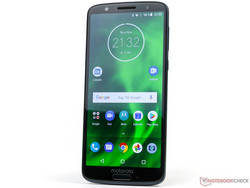
After just half dozen month, Motorola offers its latest addition of the popular Chiliad series to the customers. With a new display, drinking glass back, a dual camera, and the new Snapdragon 450, the jump turns out larger than that betwixt the Moto G5 and the G5s earlier.
Nosotros also take to emphasize positively that the manufacturer has not increased the toll. With a price of 249 Euros (~$298; around $250 in the US) at market introduction, it is still quite close to some more powerfully equipped competitors that have been available for a while, such every bit the BQ Aquaris X Pro or the in-house Moto X4, for example. Nevertheless, this volition change in the next few months when the toll will drop slowly.
Visually, the Motorola Moto G6 looks similar a Moto X4 Light and keeps many positive characteristics of its larger sibling model.
In the test, the Moto G6 mainly convinces with its practiced dual camera and the mod, bonny design. Although the smartphone is only bachelor in i color at the time of the test, we discover it very attractive. In improver, the display can exist actually bright and offers a stiff contrast ratio, and the battery life is more than decent.
We were not always happy with the quality of the WLAN connection during the test, since the quality of the connection was varying even in close proximity to the router and the range dropped rapidly if in that location was a wall between the smartphone and the router. Overall, the Motorola Moto G6 represents a successful update.
Motorola Moto G6 - 2018-05-07 05/07/2018 v6(old)
Daniel Schmidt
Smartphone - Weighted Boilerplate
Pricecompare
Daniel Schmidt, 2018-05-12 (Update: 2020-05-nineteen)
Source: https://www.notebookcheck.net/Motorola-Moto-G6-Smartphone-Review.303202.0.html

0 Response to "Motorola Moto G6 Xt1925 32gb Dual Sim (Factory Unlocked) Android Gsm 12mp 57 Review"
Post a Comment